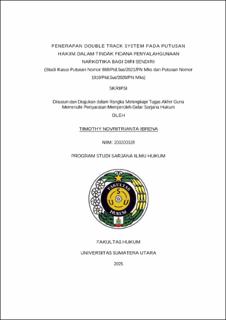| dc.description.abstract | Drug abuse remains a significant problem in Indonesia as it hinders the
country's progress in development across all aspects of life. Law Number 35 of
2009 adopts a double track system, which emphasizes equality between criminal
sanctions and rehabilitation measures. The criminal sanctions under this law
involve imprisonment, while the rehabilitation measures include medical and
social rehabilitation. The concept of the double track system is appropriate for
drug abusers because, in addition to penalizing them to deter future offenses, it is
essential for these individuals to receive rehabilitation to overcome their
addiction and reintegrate into society. Related to this, the research questions in
this thesis are: how is the double track system regulated concerning drug abuse
offenses committed by individuals; what are the theories of punishment and their
relationship with the double track system in cases of self-abuse; and how do
judges consider the application of the double track system in drug abuse cases as
seen in Verdict Number 868/Pid.Sus/2021/PN Mks and Verdict Number
1919/Pid.Sus/2020/PN Mks. The research method used in this thesis is normative
legal research, supported by secondary data consisting of primary legal
materials, secondary legal materials, and tertiary legal materials. The analysis
employed is descriptive, utilizing legislative, case, and conceptual approaches. In
both cases, Abd Wahid in Verdict Number 868/Pid.Sus/2021/PN Mks and Indra
Jaya Putra Negara in Verdict Number 1919/Pid.Sus/2020/PN Mks, the panel of
judges correctly rendered decisions based on Law Number 35 of 2009 regarding
narcotics, which adheres to the double track system concept. The judges
considered laboratory examination results and took into account Articles 54, 55,
103, 127, and Supreme Court Circular Number 4 of 2010 concerning the
placement of drug abuse victims into medical and social rehabilitation
institutions. According to Article 103 of the Narcotics Law, judges can order drug
abusers into rehabilitation centers if found guilty. The classification for someone
to be considered a drug abuser is outlined in Supreme Court Circular Number 4
of 2010, which states that in cases involving methamphetamine abuse, it should
not exceed 1 gram per day. In Abd Wahid's case, the evidence indicated
methamphetamine with an initial weight of 0.0402 grams and a final weight of
0.0288 grams; for Indra Jaya Putra Negara, the evidence was methamphetamine
in a clear plastic sachet with an initial weight of 0.0595 grams
Keywords: Abuse, Narcotics, Double Track System. | en_US |


